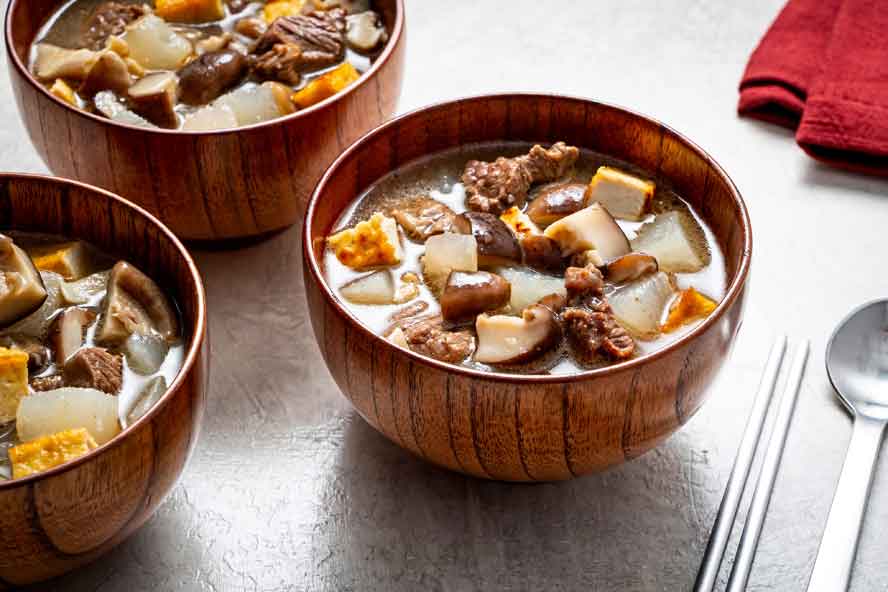 Scott Suchman for The Washington Post
Scott Suchman for The Washington Post
Inspired by the version made by food writer James Park's family in the southeast part of South Korea, this recipe features a clean, flavorful broth with cubes of pan-fried tofu and shiitakes. It is traditionally served as part of jesa, a ceremony performed as part of the Lunar New Year. The name "Tang-Guk" loosely translates to "soup-soup," referring to merging styles in the dish. Similar soups go by other names, depending on the region.
Korean soup soy sauce, such as the one made by Sempio, is not as salty or dark as regular soy sauce. It is critical to the final result and should not be substituted. If you can't find it, consider a seasoning sauce, such as one made by Yondu brand, which works similarly. If more seasoning is desired, use salt to taste.
Storage Notes: Refrigerate leftovers for up to 5 days.
Where to Buy: Korean soup soy sauce can be found at Asian markets or online; daikon can be found at well-stocked supermarkets or Asian markets.
TANG-GUK (Beef and Radish Soup)
MAKES: 4-6 servings; about 2 quarts
ACTIVE TIME: 45 mins; Total time: 1 hour 10 mins
INGREDIENTS
For the pineapple filling
• 1 pound fresh shiitakes, stems removed
• 1 1/2 pounds Korean daikon radish (mu), peeled
• 2 tablespoons extra-virgin olive oil
• 1 pound firm tofu, sliced into 1/2-inch-thick planks
• 2 tablespoons toasted sesame oil
• 1 pound beef, preferably chuck, sliced into bite-size pieces
• 6 cups water, divided
• 1 tablespoon fine salt, plus more to taste
• 4 teaspoons Korean soup soy sauce, such as Sempio brand
• Cooked white rice, for serving (optional)
Storage Notes: Refrigerate leftovers for up to 5 days.
DIRECTIONS
Bring a large pot of water to a boil over high heat. Reduce the heat to medium, add the mushrooms and cook for about 3 minutes. Drain into a colander and let sit until cool enough to handle. Chop the mushrooms into 1/2-inch pieces and set aside.
Slice the daikon into 1-inch-thick discs. Depending on the length of the radish, you should get 8 to 10 pieces. Cut each disk into batons about 1/2-inch wide, then cut each baton across into 1/4-inch thick chunks.
In a skillet, preferably nonstick, over medium-high heat, heat the olive oil until shimmering. Meanwhile, pat the tofu slices dry with paper towels or a clean kitchen towel. Fry the tofu until browned on each side, 4 to 5 minutes per side. Transfer to a cutting board and cut into cubes roughly the same size as the mushrooms.
In the same pot used for blanching the mushrooms, over medium heat, heat the sesame oil until shimmering. Add the beef and cook, stirring frequently, until the meat is no longer pink, 2 to 3 minutes. Add the radish, 1/2 cup of water and the salt and simmer while continuously stirring to avoid sticking on the bottom, until the radish starts to look translucent, 8 to 10 minutes. Add the remaining 5 1/2 cups of water to the pot, along with the tofu and shiitakes. Bring it to a boil, then reduce the heat to medium-low, and simmer until the radish is tender, 20 to 25 minutes. There should be enough broth to just cover the vegetables, meat and tofu.
Turn off the heat, add the Korean soup soy sauce (see headnote), and season to taste with salt, if desired. Serve the soup as is, or with a bowl of rice on the side.
JewishWorldReview.com publishes delicious -- mostly nutritious -- recipes. Sign up for the daily JWR update. It's free. Just click here.
(COMMENT, BELOW)


 Contact The Editor
Contact The Editor
 Articles By This Author
Articles By This Author